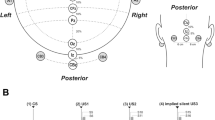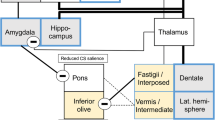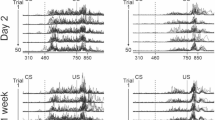Abstract
Timing and amplitude parameters of unconditioned eyeblink responses were investigated in 24 patients with unilateral cerebellar lesions following infarcts within the territory of the superior cerebellar artery (SCA, n=12) and of the posterior inferior cerebellar artery (PICA, n=12). The extent of cortical cerebellar lesions, i.e., which lobules were affected and possible involvement of cerebellar nuclei, was determined by three-dimensional magnetic resonance imaging (3D MRI). Amplitude parameters of eyeblink responses were normalized and expressed as percentage of the unaffected side in patients and the second tested side in age-matched controls. Normalized peak amplitudes, burst area and burst duration were significantly increased in SCA patients with lesions restricted to cortical areas. Burst onset and time to peak were not significantly different compared with controls. Temporal and amplitude parameters of eyeblink responses were unchanged in SCA patients with additional involvement of cerebellar nuclei and in patients with lesions of the PICA territory. Consistent with animal lesion and recording studies and a recent human functional magnetic resonance imaging (fMRI) study, the present data suggest that cortical areas of the superior cerebellum are of importance in eyeblink control in humans. These areas partly overlap with areas known to be critical in eyeblink conditioning.




Similar content being viewed by others
References
Amarenco P, Rosengart A, DeWitt LD, Pessin MS, Caplan LR (1993) Anterior inferior cerebellar artery territory infarcts. Mechanisms and clinical features. Arch Neurol 59:154–161
Aramideh M, Ongerboer de Visser BW, Koelman JH, Majoie CB, Holstege G (1997) The late blink reflex response abnormality due to lesion of the lateral tegmental field. Brain 120:1685–1692
Blaxton TA, Zeffiro TA, Gabrieli JD, Bookheimer SY, Carrillo MC, Theodore WH, Disterhoft JF (1996) Functional mapping of human learning: a positron emission tomography activation study of eyeblink conditioning. J Neurosci 16:4032–4040
Bloedel JR, Bracha V (1995) On the cerebellum, cutaneomuscular reflexes, movement control and the elusive engrams of memory. Behav Brain Res 68:1–44
Bracha V, Webster ML, Winters NK, Irwin KB, Bloedel JR (1994) Effects of muscimol inactivation of the cerebellar interposed-dentate nuclear complex on the performance of the nictitating membrane response in the rabbit. Exp Brain Res 100:453–468
Clark GA, McCormick DA, Lavond DG, Thompson RF (1984) Effects of lesions of cerebellar nuclei on conditioned behavioral and hippocampal neuronal responses. Brain Res 291:125–136
Daum I, Schugens MM, Ackermann H, Lutzenberger W, Dichgans J, Birbaumer N (1993) Classical conditioning after cerebellar lesions in humans. Behav Neurosci 107:748–756
Dimitrova A, Weber J, Maschke M, Elles HG, Kolb FP, Forsting M, Diener HC, Timmann D (2002a) Eyeblink-related areas in human cerebellum as shown by fMRI. Hum Brain Mapp 17:100–115
Dimitrova A, Weber J, Redies C, Kindsvater K, Maschke M, Kolb FP, Forsting M, Diener HC, Timmann D (2002b) MRI atlas of the human cerebellar nuclei. Neuroimage 17:240–255
Esteban A (1999) A neurophysiological approach to brainstem reflexes. Blink reflex. Neurophysiol Clin 29:7–38
Evans AC, Kamber M, Collins DL, MacDonald D (1994) An MRI-based probablistic atlas of neuroanatomy. In: Shorvon S, Fish D, Andermann F, Bydder GM, Stefan H (eds) Magnetic resonance scanning and epilepsy. Plenum, New York, pp 263–274
Gerwig M, Dimitrova A, Kolb FP, Maschke M, Brol B, Kunnel A, Böring D, Thilmann AF, Forsting M, Diener HC, Timmann D (2003) Comparison of eyeblink conditioning in patients with superior and posterior inferior cerebellar lesions. Brain 126:71–94
Green JT, Woodruff-Pak DS (2000) Eyeblink classical conditioning: hippocampal formation is for neutral stimulus associations as cerebellum is for association-response. Psychol Bull 126:138–158
Gruart A, Yeo CH (1995) Cerebellar cortex and eyeblink conditioning: bilateral regulation of conditioned responses. Exp Brain Res 104:431–448
Hacke W, Schaff C, Zeumer H (1983) Orbicularis oculi reflex in computerized tomography verified lesions of the posterior cranial fossa. Fortschr Neurol Psychiatr 51:313–324
Harvey JA, Welsh JP, Yeo CH, Romano AG (1993) Recoverable and nonrecoverable deficits in conditioned responses after cerebellar cortical lesions. J Neurosci 13:1624–1635
Hesslow G (1994) Correspondence between climbing fibre input and motor output in eyeblink-related areas in cat cerebellar cortex. J Physiol 476:229–244
Holstege G, Tan J, van Ham JJ, Graveland GA (1986) Anatomical observations on the afferent projections to the retractor bulbi motoneuronal cell group and other pathways possibly related to the blink reflex in the cat. Brain Res 374:321–334
Ito M (1984) The cerebellum and neural control. Raven Press, New York
Logan CG (1991) Cerebellar cortical involvement in excitatory and inhibitory classical conditioning. Unpublished doctoral dissertation, Stanford University
Logan CG, Grafton ST (1995) Functional anatomy of human eyeblink conditioning determined with regional cerebral glucose metabolism and positron-emission tomography. Proc Natl Acad Sci U S A 92:7500–7504
MacKay WA, Murphy JT (1979) Cerebellar modulation of reflex gain. Prog Neurobiol 13:361–417
Mauk MD, Ruiz BP (1992) Learning-dependent timing of Pavlovian eyelid responses: differential conditioning using multiple interstimulus intervals. Behav Neurosci 106: 666–681
McCormick DA, Thompson RF (1984) Neuronal responses of the rabbit cerebellum during acquisition and performance of a classically conditioned nictitating membrane-eyelid response. J Neurosci 4:2811–2822
Molchan SE, Sunderland T, McIntosh AR, Herscovitch P, Schreurs BG (1994) A functional anatomical study of associative learning in humans. Proc Natl Acad Sci U S A 91:8122–8126
Morcuende S, Delgado-Garcia JM, Ugolini G (2002) Neuronal premotor networks involved in eyelid responses: retrograde transneuronal tracing with rabies virus from the orbicularis oculi muscle in the rat. J Neurosci 22:8808–8818
Ongerboer de Visser BW (1983a) Anatomical and functional organization of reflexes involving the trigeminal system in man: jaw reflex, blink reflex, corneal reflex, and exteroceptive suppression. In: Desmedt JE (ed) Advances in Neurology, vol 39. Raven Press, New York, pp 727–738
Ongerboer de Visser BW (1983b) Comparative study of corneal and blink reflex latencies in patients with segmental or with cerebral lesions. In: Desmedt JE (ed) Advances in Neurology, vol 39. Raven Press, New York, pp 757–772
Pellegrini JJ, Evinger C (1997) Role of the cerebellum in adaptive modification of reflex blinks. Learn Mem 3:77–87
Peshori KR, Schicatano EJ, Gopalaswamy R, Sahay E, Evinger C (2001) Aging of the trigeminal blink system. Exp Brain Res 136:351–363
Ramnani N, Toni I, Josephs O, Ashburner J, Passingham RE (2000) Learning- and expectation-related changes in the human brain during motor learning. J Neurophysiol 84:3026–3035
Raymond JL, Lisberger SG, Mauk MD (1996) The cerebellum: a neuronal learning machine? Science 272:1126–1131
Rorden C, Brett M (2000) Stereotaxic display of brain lesions. Behav Neurol 12:191–200
Schmahmann JD, Dojon J, Toga AW, Petrides M, Evans AC (2000) MRI atlas of the human cerebellum. Academic Press, San Diego
Schreurs BG, McIntosh AR, Bahro M, Herscovitch P, Sunderland T, Molchan SE (1997) Lateralization and behavioral correlation of changes in regional cerebral blood flow with classical conditioning of the human eyeblink response. J Neurophysiol 77:2153–2163
Sibony PA, Evinger C (1998) Anatomy and physiology of normal and abnormal eyelid position and movement. In: Millner NR (ed) Walsh and Hoyt’s clinical neuroophthalmology, 5th edn. Williams and Wilkins, Baltimore, pp 1509–1592
Steinmetz JE, Lavond DG, Ivkovich D, Logan CG, Thompson RF (1992) Disruption of classical eyelid conditioning after cerebellar lesions: damage to a memory trace system or a simple performance deficit? J Neurosci 12:4403–4426
Thompson RF, Bao S, Chen L, Cipriano BD, Grethe JS, Kim JJ, Thompson JK, Tracy JA, Weninger MS, Krupa DJ (1997) Associative learning. Int Rev Neurobiol 41:151–189
Thompson RF, Swain R, Clark R, Shinkman P (2000) Intracerebellar conditioning—Brodgen and Gantt revisited. Behav Brain Res 110:3–11
Timmann D, Baier C, Diener HC, Kolb FP (1998) Impaired acquisition of limb flexion reflex and eyeblink classical conditioning in a cerebellar patient. Neurocase 4:207–217
Topka H, Valls-Sole J, Massaquoi SG, Hallett M (1993) Deficit in classical conditioning in patients with cerebellar degeneration. Brain 116:961–969
Trouillas P, Takayanagi T, Hallett M, Currier RD, Subramony SH, Wessel K, Bryer A, Diener HC, Massaquoi S, Gomez CM, Coutinho P, Ben Hamida M, Campanella G, Filla A, Schut L, Timmann D, Honnorat J, Nighoghossian N, Manyam B (1997) International cooperative ataxia rating scale for pharmacological assessment of the cerebellar syndrome. The Ataxia Neuropharmacology Committee of the World Federation of Neurology. J Neurol Sci 145:205–211
van Ham JJ, Yeo CH (1992) Somatosensory trigeminal projections to the inferior olive, cerebellum and other precerebellar nuclei in rabbits. Eur J Neurosci 4:302–317
Welsh JP, Harvey JA (1989) Cerebellar lesions and the nictitating membrane reflex: performance deficits of the conditioned and unconditioned response. J Neurosci 9:299–311
Woodruff-Pak DS, Steinmetz JE (2000a) Eyeblink classical conditioning: Volume I. Applications in humans. Kluwer Academic Publisher, Boston, Dordrecht, London
Woodruff-Pak DS, Steinmetz JE (2000b) Eyeblink classical conditioning: Volume II. Animal models. Kluwer Academic Publisher, Boston, Dordrecht, London
Woodruff-Pak DS, Papka M, Ivry RB (1996) Cerebellar involvement in eyeblink classical conditioning in humans. Neuropsychology 10:443–458
Yeo CH, Hardiman MJ (1992) Cerebellar cortex and eyeblink conditioning: a reexamination. Exp Brain Res 88:623–638
Yeo CH, Hesslow G (1998) Cerebellum and conditioned reflexes. Trends Cognit Sci 2:322–330
Yeo CH, Hardiman MJ, Glickstein M (1985a) Classical conditioning of the nictitating membrane response of the rabbit I. Lesions of the cerebellar nuclei. Exp Brain Res 60:87–98
Yeo CH, Hardiman MJ, Glickstein M (1985b) Classical conditioning of the nictitating membrane response of the rabbit II. Lesions of the cerebellar cortex. Exp Brain Res 60:99–113
Acknowledgements
The study was supported by a grant of the Deutsche Forschungsgemeinschaft (DFG Ti 239/7-1). The authors would like to thank Beate Brol for her help in eyeblink data analysis and preparation of the figures and Asha Kunnel for her help in analyzing part of the MR data.
Author information
Authors and Affiliations
Corresponding author
Rights and permissions
About this article
Cite this article
Gerwig, M., Dimitrova, A., Maschke, M. et al. Amplitude changes of unconditioned eyeblink responses in patients with cerebellar lesions. Exp Brain Res 155, 341–351 (2004). https://doi.org/10.1007/s00221-003-1731-y
Received:
Accepted:
Published:
Issue Date:
DOI: https://doi.org/10.1007/s00221-003-1731-y




